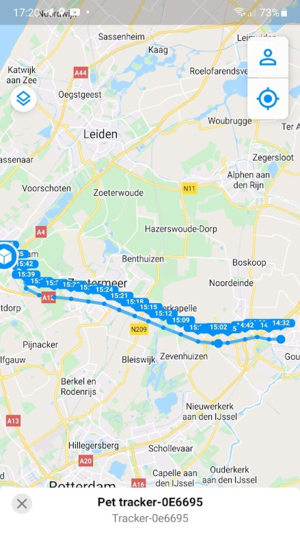SigfoxTracker: Difference between revisions
Jump to navigation
Jump to search
No edit summary |
|||
| Line 20: | Line 20: | ||
* modulation is D-BPSK, frequency range is 192 kHz is in the 868 MHz band | * modulation is D-BPSK, frequency range is 192 kHz is in the 868 MHz band | ||
* a packet consists of max 26 bytes, of which 12 bytes are user payload | * a packet consists of max 26 bytes, of which 12 bytes are user payload | ||
Interesting reading: | |||
* https://www.disk91.com/2019/technology/sigfox/make-you-own-1-sigfox-iot-device/ | |||
* https://www.disk91.com/2019/news/sigfox-news/i-held-the-first-1-sigfox-iot-device/ | |||
* https://www.disk91.com/2018/technology/sigfox/create-a-5-autonomous-tracker-with-esp8266-and-sigfox/ | |||
=== coverage === | |||
[[File:sigfox_coverage_1.png|right|thumb|Sigfox coverage, bike trip Gouda-Leidschendam]] | |||
Revision as of 15:56, 8 May 2022
| Project SigfoxTracker | |
|---|---|

| |
| Investigating sigfox location trackers | |
| Status | Initializing |
| Contact | bertrik |
| Last Update | 2022-05-08 |
What
This page is about investigation of Sigfox location trackers, e.g.:
- how existing trackers work
- coverage of the sigfox network
- how to interact with the sigfox backend
- ultimately, help develop a sigfox tracker for tracking small animals, like bats
Investigation
- great page at disk91 about sigfox, part from reverse engineering
- coverage map https://www.sigfox.com/en/coverage
- modulation is D-BPSK, frequency range is 192 kHz is in the 868 MHz band
- a packet consists of max 26 bytes, of which 12 bytes are user payload
Interesting reading:
- https://www.disk91.com/2019/technology/sigfox/make-you-own-1-sigfox-iot-device/
- https://www.disk91.com/2019/news/sigfox-news/i-held-the-first-1-sigfox-iot-device/
- https://www.disk91.com/2018/technology/sigfox/create-a-5-autonomous-tracker-with-esp8266-and-sigfox/
